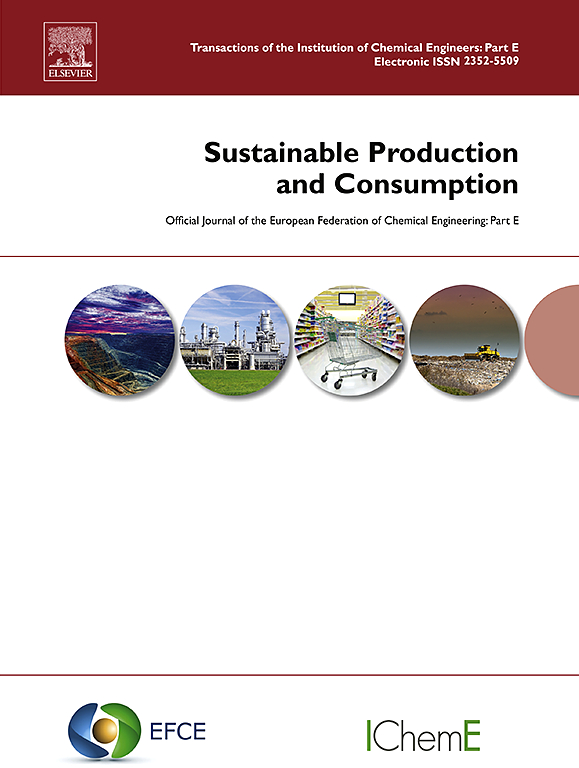从区域化生命周期角度对2050年法国食品消费情景的环境影响和资源临界性进行联合评估
IF 10.9
1区 环境科学与生态学
Q1 ENVIRONMENTAL STUDIES
引用次数: 0
摘要
结合饮食、供应链和农业实践的变化,提出了2050年法国食品消费的五种预期情景,其中包括一切照旧(BAU)的情况。本研究旨在根据区域化生命周期的观点,对它们的环境影响和资源临界性进行联合评估。通过46种代表性产品对食品消费进行建模。考虑到饮食、农业实践、粮食进口来源和数量以及能源组合等因素,这些产品的生命周期清单(LCI)被参数化,以与每种情景保持一致。使用IMPACT World+方法计算区域影响,并基于联合研究中心临界度方法量化矿产资源、土地、水和农产品的供应风险潜力(SRP)指数。结果表明,在所有影响类别中,四种情景中的三种情景的环境影响都低于BAU情景。对于气候变化,影响可以减少25%到45%。在资源临界性方面也观察到类似的结果。这些结果主要是由于饮食的变化,总体消费水平降低,动物产品的比例减少。磷肥和钾肥的使用受到农业做法的强烈影响,是造成矿物资源危急的主要因素。根据肉制品在日粮中所占的份额,牧场对土地SRP的贡献很大。同样,肉类消费通过动物饲料影响农业SRP。最后,水SRP主要由水力发电驱动。敏感性分析突出了矿产资源和农产品的环境破坏与资源临界性之间的潜在权衡(环境影响越大,SRP越低)。此外,影响的区域化可能导致在给定情景下影响结果的差异高达50%。因此,需要作出更多的努力,考虑到农业低成本国家的当地条件和做法。本文章由计算机程序翻译,如有差异,请以英文原文为准。

Joint assessment of the environmental impacts and resource criticality of French food consumption scenarios in 2050 from a regionalised life cycle perspective
Five prospective scenarios combining changes in diets, supply chains, and agricultural practices have been proposed for French food consumption in 2050, including a business-as-usual (BAU) situation. This study aims to perform a joint assessment of their environmental impacts and resource criticality according to a regionalised life cycle perspective.
Food consumption is modelled through 46 representative products. The life cycle inventories (LCI) of these products were parameterized to be consistent with each scenario, considering factors such as diets, agricultural practices, origin and volume of food imports, and energy mixes. The IMPACT World+ method is used to compute regionalised impacts, and Supply Risk Potential (SRP) indices are quantified for mineral resources, land, water and agricultural products based on the Joint Research Centre criticality method.
The results reported that three of the four scenarios have lower environmental impacts than the BAU scenario for all impact categories. For climate change, impacts could be reduced by between 25 % and 45 %. Similar results were observed for resource criticality. These results were mainly explained by the change in diets, with lower levels of overall consumption, and less animal products in proportion.
Phosphate and potassium fertilisers use, strongly influenced by agricultural practices, was the primary contributors to mineral resources criticality. Depending on the share of meat products in diets, pastures contributed significantly to land SRP. In the same way, meat consumption influenced agricultural SRP through animal feed. Finally, water SRP was mainly driven by hydropower production for electricity.
The sensitivity analysis highlighted potential trade-offs between environmental damage and resource criticality for mineral resources and agricultural products (higher environmental impacts lead to lower SRP). Furthermore, the regionalisation of impacts can lead to variations of up to 50 % in impact results for a given scenario. Additional efforts are thus needed for considering local conditions and practices in agricultural LCIs.
求助全文
通过发布文献求助,成功后即可免费获取论文全文。
去求助
来源期刊

Sustainable Production and Consumption
Environmental Science-Environmental Engineering
CiteScore
17.40
自引率
7.40%
发文量
389
审稿时长
13 days
期刊介绍:
Sustainable production and consumption refers to the production and utilization of goods and services in a way that benefits society, is economically viable, and has minimal environmental impact throughout its entire lifespan. Our journal is dedicated to publishing top-notch interdisciplinary research and practical studies in this emerging field. We take a distinctive approach by examining the interplay between technology, consumption patterns, and policy to identify sustainable solutions for both production and consumption systems.
 求助内容:
求助内容: 应助结果提醒方式:
应助结果提醒方式:


